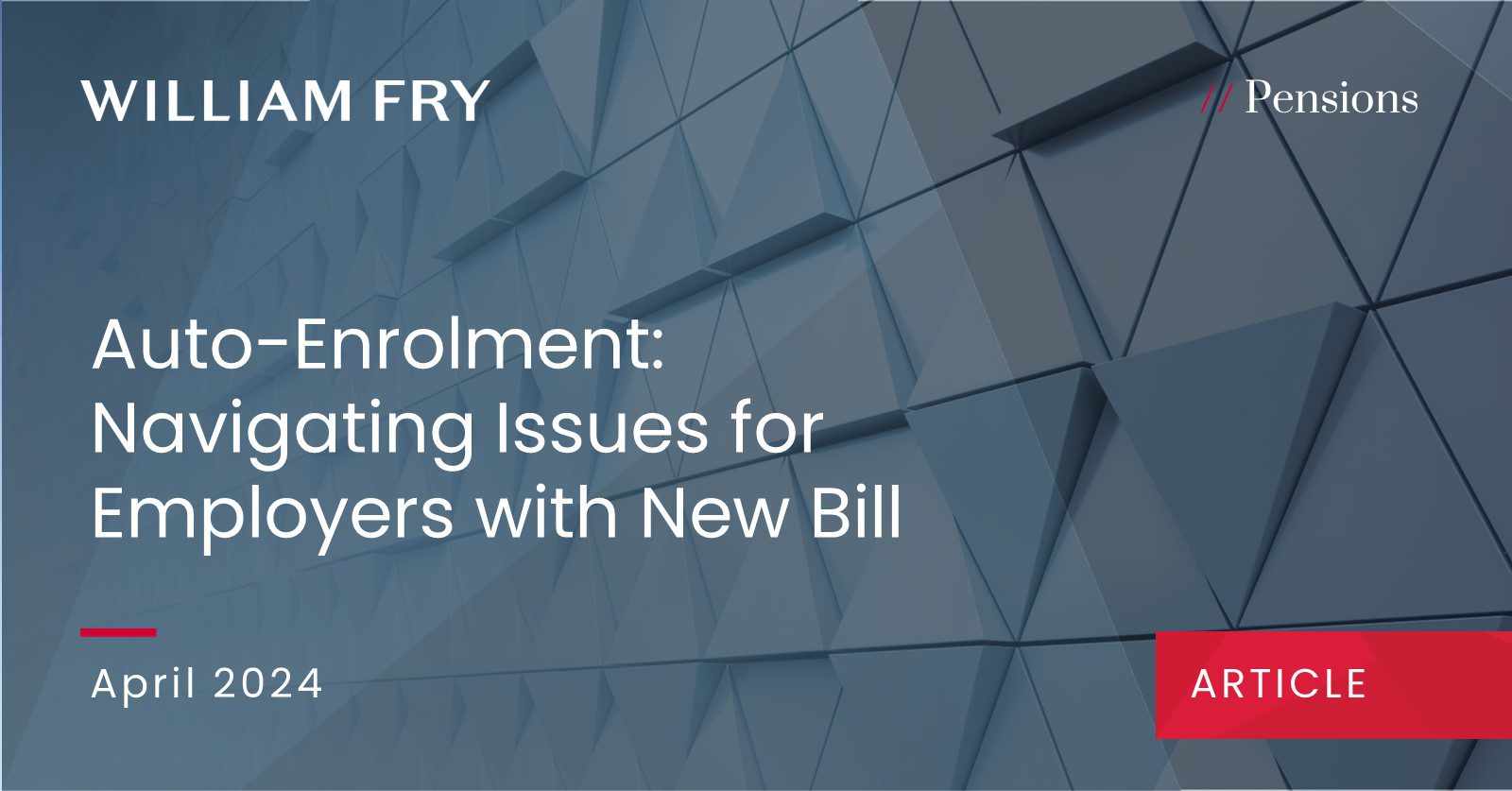The long-awaited Automatic Enrolment Retirement Savings System Bill 2024 (AE Bill) was published by the government last week.
This landmark legislation sets the framework for the introduction of the automatic enrolment (AE) retirement savings system in Ireland. It is intended that the first workers will be enrolled into the AE system in January 2025. This leaves employers with a relatively short timeframe within which to assess the implications of the AE Bill and plan accordingly.
In this article, we outline some of the immediate issues arising for employers and provide a brief overview of the key aspects of the AE Bill from an employer perspective.
Employees within Scope
The AE regime will apply to employees aged between 23 and 60, on gross pay in excess of €20,000 per annum and who are not already in “exempt employment”. Broadly speaking, “exempt employment” arises when an employee participates in a pension scheme or PRSA, and pension contributions are either paid by the employee or paid in respect of the employee by their employer.
At present, there is no minimum threshold on employee or employer contributions for employment to be considered an “exempt employment”. However, the AE Bill makes provision for the establishment of a National AE Retirement Savings Authority (AE Authority) to run the system and develop standards for pension schemes or PRSAs to be deemed a “qualifying” arrangement. This suggests that, in time, pension schemes and PRSAs will have to meet minimum contribution thresholds for employees to continue to be regarded as being in “exempt employment”, and outside the scope of the AE system.
Contributions
The AE system is designed to operate based on matching employer and employee contributions with an additional State contribution. The rates of contribution, which will increase over time, are set out in the table below:
| Employee Contribution | Employer Contribution | State Contribution | TOTAL | |
|---|---|---|---|---|
| Years 1 – 3 | 1.5% | 1.5% | 0.5% | 3.5% |
| Years 4 – 6 | 3% | 3% | 1% | 7% |
| Years 7 – 9 | 4.5% | 4.5% | 1.5% | 10.5% |
| Year 10 onwards | 6% | 6% | 2% | 14% |
These contributions will be calculated based on gross pay of up to a maximum of €80,000 per annum.
Where employees fall within the scope of the AE system, the AE Authority will notify their employers via a payroll notification (Payroll Notification), of contributions payable to the AE system. Upon receipt of the Payroll Notification employers must:
- calculate, deduct, and pay employee contributions to the AE Authority in respect of the employees covered by the Payroll Notification; and
- calculate and pay corresponding employer contributions to the AE Authority.
Opt-Out / Opt-In
Employees will have a limited right to opt-out of the AE system. Employees may opt-out during months seven and eight after having been enrolled or re-enrolled. Where employees opt-out they are entitled to a refund of their own contributions. The AE Bill does not provide for a refund of employer contributions.
The AE Bill makes provision for auto re-enrolment following an opt-out. The AE Authority has the power to re-enrol employees two years following an opt-out, where they are aged under 66 and not in “exempt employment”.
Separately, the AE Bill provides for employees who are not within the scope of the AE system with a right to opt-in to the AE system if they are aged between 18 and 66 and not already in “exempt employment”.
Employer Issues
The AE Bill presents a range of issues that employers need to consider in planning for this new regime.
At one level, employers could decide to simply take no action and address AE compliance upon receipt of a Payroll Notification from the AE Authority. This would mean continuing to operate any existing pension arrangement “as is”, i.e., a “dual scheme” approach. Alternatively, employers could use their existing pension scheme or PRSA to address AE compliance. The pension scheme or PRSA offering could be re-designed so that all employees are considered to be in “exempt employment” and not within the scope of AE, i.e., a “single scheme” approach.
There are advantages and disadvantages to both approaches and employers will need to assess the most suitable for their business. This will involve considering a range of issues including:
- Identifying employees that are within the scope of AE
The number of employees not in a pension scheme or PRSA or in respect of whom no employer or employee pension contributions are being paid will need to be identified. This will provide employers with a sense of the scale of the issue AE may create for their business. - Assessing the costs and administrative issues associated with a “single scheme” or “dual scheme” approach
As AE contributions are based on gross pay and most pension schemes calculate contributions based on basic pay, the “single scheme” and “dual scheme” approach will result in different cost outcomes. Operating a different basis to calculate contribution rates for AE versus an existing scheme is also likely to create an administrative burden at the payroll level and increase the risk of associated errors. - Considering the employment law implications of a “single scheme” versus a “dual scheme” approach
The AE Bill does not provide employers with statutory power to enrol employees into their existing pension scheme or PRSA to address AE compliance. If it is decided to follow a “single scheme” approach, the employment law implications of contractually auto-enrolling current and future employees into an existing scheme will have to be worked through carefully. - Considering whether any benefit design changes to existing pension arrangements may be required arising from AE
Moving to a “single scheme” approach may require amendments to eligibility rules and contribution rates. Those benefit design changes will require careful consideration. - Considering the employee relations issues of a “single scheme” versus a “dual scheme” approach
The design of the AE system is very different to the benefit design of typical Irish pension schemes. Therefore, with a “dual scheme” approach, employers will end up with two cohorts of employees potentially paying different rates of contributions and building up benefits that are very different in value. This has the potential to create employee relations issues for employers where one group may be aggrieved at higher benefits being enjoyed by the other group.
These are just some of the issues employers will need to consider in planning for AE. That planning should start without delay given the imminent operation of the AE system.
Timing for the launch of AE
A significant amount of work remains to be done at government level around the establishment of the AE Authority and the intended operation date of January 2025 to cater for circa 800,000 workers. Despite these challenges, Minister Humphreys has indicated a commitment to the date. The AE Bill, as currently drafted, will be commenced by Ministerial Order. Therefore, the Minister will have some flexibility in deciding on the timing of its enactment if January 2025 proves to be too ambitious.
Please feel free to contact Ian Devlin, Ciara McLoughlin, Jane Barrett or your usual William Fry contact if you need any support relating to AE or its implications for your business.
Contributed by Ciara Kelliher




